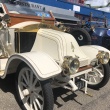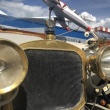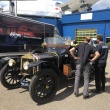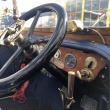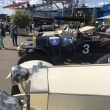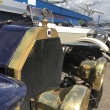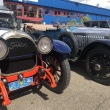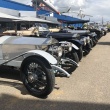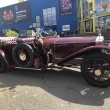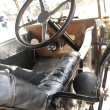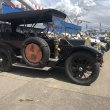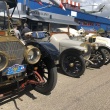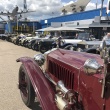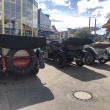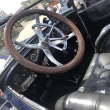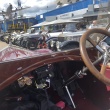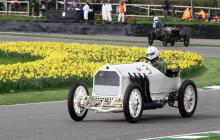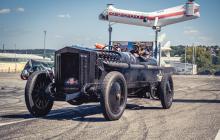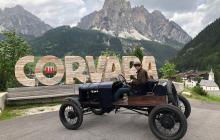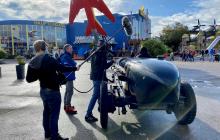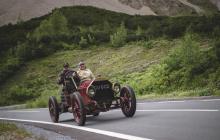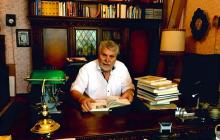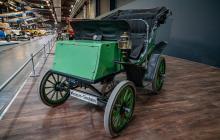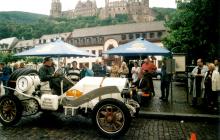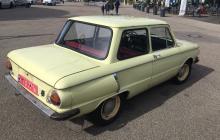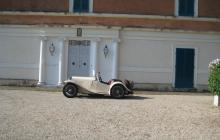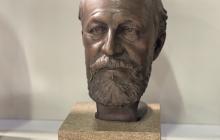It was an ordinary Tuesday afternoon at the Technik Museum Sinsheim. The two super birds, Tupolev Tu-144 and the Concorde, were sparkling in the midday sun, the museum visitors were relaxing on the terrace of the restaurant after their tour, children were playing joyfully on the playground close by. Suddenly, something was happening in the entrance area of the museum. It is not unusual to see vintage cars parking on the museum’s courtyard from time to time. This time, however, the visitors were able to witness an unusual situation: about 20 vintage cars were driving into the courtyard of the museum and parked in rank and file. One car more beautiful than the other: Rolls Royce, Crane Simplex, Brasier, Oldsmobile, Peugeot, Sunbeam, Lancia as well as Arrol Johnston – some of these brands had already disappeared from the market a long time ago. Since most of the cars were from before the First World War, we offered a repair service for some of the vehicles. Windswept, exhausted from the ride, but also very satisfied, Daniel Ward, the organiser of this unique rally agreed to answer our questions.
Museum: You are driving some very precious vehicles. What is this trip, the so-called “Orient Express 2019”, about?
Ward: Our rally leads us from The Hague in the Netherlands to Istanbul in Turkey. The goal of the rally is to bring the vintage cars – all of them built before 1920 – to the three largest museums in Europe. We started at the Louwman Museum – the owner is one of the participants by the way. For today, we have reached our goal: we have arrived at Hermann Layher at the Technik Museum Sinsheim. His museum hosts a worldwide very unique collection. We are very honoured that he is organising a dinner for us tonight. Every participant of the rally is already looking forward to this event. Tomorrow, we will continue our rally well rested.
Museum: You will continue well rested but you still have a long way to go...
Ward: We will have to drive a long way in the next few days. In the beginning, we will drive to Italy via Lindau, Innsbruck, Padua and Rimini. Afterwards, we will continue to Greece until we finally arrive in Turkey. We will cross the peninsula on a ferry to the east where Europe merges with Asia. After arriving in Bursa, a city with over a million inhabitants, we will take another ferry to Istanbul in order to eventually end up at the Rami M. Koc Museum. This museum also exhibits a remarkable collection in the name of its founder ... just as it is the case with Hermann Layher. The owner also invited us for dinner. We really appreciate that every museum founder or owner invites us for dinner. It almost seems as if we are driving from one dinner to another in our veteran cars.
Museum: Thank you, you have just answered some of my planned questions beforehand. The rally is called “The Orient Express 2019”. So, does it take place every year, will there be one next year?
Ward: Well, this rally is the first and the last one. However, I organise one for my friends each year. It is completely different every time – we never do a trip twice. The only condition for the rally is: we try to reconstruct historic events. The first time that someone drove from London to Istanbul by car was in 1907 in a one-cylinder Rover ... the tours have become easier ever since.
Museum: Okay. So, you started in The Hague in the Netherlands – have you had any problems since then?
Ward: Well ... nothing unusual. These vintage cars usually have some problems with clogged fuel lines or with the ignition. One of the main problems is that, at a certain point, people have installed different parts to the starter or the fuel pump. It is usually the modifications that cause the problems, not the antique parts.
Museum: There is usually some kind of price in historic rallies like yours. Do you do it just for fun or is there another reason?
Ward: No, it is just for fun. The whole thing is privately organised and does not generate any profit. It is not for a charitable purpose either ... it is purely an event for vintage car enthusiasts.
Museum: With all of these fantastic cars – which one is the oldest or the most interesting?
Ward: Well, there is a difference between the oldest and the most interesting car. The oldest car is one of my vehicles. To be precise, four vehicles in the rally are mine. The oldest is a Talbot from 1908. One of my good friends is driving that one. Although it is this old, it still has a lot of power with its 6.5 litres. As for the most interesting car ... well, that is a matter of opinion. In this rally, we have a few Rolls Royce Silver Ghost from all over the world: from South and North America, even one from New Zealand. The Silver Ghosts are very popular. In fact, one Silver Ghost from Mexico has just arrived. It is also one of the most important vehicles at this event: with its original Kellner bodywork, the car is truly fantastic. However, my personal favourite at this rally is a car that I would love to own myself ... a Peugeot with a total of 150 hp. It is a very beautiful car, so unique and fast.
Museum: Do you only use specific roads or do you also use the highway?
Ward: We try to avoid the highway because it is simply no fun. Driving alone at high speed with an old car is not satisfactory at all. And since some of the cars do not have a real top, you can only do rallies like this one in good weather. We also choose roads where you can drive comfortably and overland. Plus, we do not want to be an obstruction for other road users ... all we want is to enjoy the ride. I mean, driving on the highway does not necessarily require a lot of skill ... in fact, it is rather boring and also very bad for the car’s mechanism. Back then (1910/1912), cars were never developed for continuous speed. Their whole lubrication is a lot better when the engine does not constantly operate at a high rotation speed, especially on-load, they do not like it. It is possible but they do not like it. Plus, it is simply not interesting.
The stories and reports represent the opinions and perspectives of the respective authors. Please note, especially while reading articles about our events, that binding information (e.g. opening hours, admission fees and programme) is only published on the museum's official website www.technik-museum.de.
Please note that the pictures, texts and videos published here are subject to the copyright of the respective authors and / or the museum and may not be used without permission.
Keep up-to-date with new articles
We recommend to subscribe to the museum’s newsletter via e-mail. At the end of each newsletter, we inform you about new articles so that you will not miss any of them. Alternatively, you can subscribe to an RSS feed:
Subscribe to newsletter RSS-Feed (Reader required)

